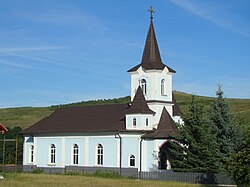Cămărașu
Cămărașu | |
|---|---|
 Reformed church în Cămărașu village | |
 Location in Cluj County | |
| Coordinates: 46°47′35″N 24°7′45″E / 46.79306°N 24.12917°E | |
| Country | Romania |
| County | Cluj |
| Established | 1322 |
| Subdivisions | Cămărașu, Năoiu, Sâmboleni |
| Government | |
| • Mayor (2020–2024) | Iancu Marcel Mocean[1] (Ind.) |
Area | 51 km2 (20 sq mi) |
| Elevation | 360 m (1,180 ft) |
| Population (2021-12-01)[2] | 2,591 |
| • Density | 51/km2 (130/sq mi) |
| Time zone | EET/EEST (UTC+2/+3) |
| Postal code | 407140 |
| Area code | +(40) x64 |
| Vehicle reg. | CJ |
| Website | www |
Cămărașu (Hungarian: Pusztakamarás; German: Kammerischdorf) is a commune in Cluj County, Transylvania, Romania. It is composed of three villages: Cămărașu, Năoiu (Novoly), and Sâmboleni (Mezőszombattelke).
Geography
The commune is situated on the Transylvanian Plateau, at an altitude of 360 m (1,180 ft), on the banks of the rivers Fizeș and Frata. It is located in the eastern part of Cluj County, 45 km (28 mi) from the county seat, Cluj-Napoca, on the border with Bistrița-Năsăud and Mureș counties. Its neighbors are: Budești commune to the east, the town of Sărmașu to the east and south, Mociu commune to the west, and Cătina commune to the north.
Cămărașu is crossed by national road DN16, which starts in Cluj-Napoca and ends in Reghin, 56 km (35 mi) to the east.
Demographics
| Year | Pop. | ±% |
|---|---|---|
| 1850 | 1,983 | — |
| 1880 | 1,773 | −10.6% |
| 1900 | 2,492 | +40.6% |
| 1910 | 2,658 | +6.7% |
| 1920 | 2,495 | −6.1% |
| 1930 | 3,028 | +21.4% |
| 1941 | 3,361 | +11.0% |
| 1956 | 4,145 | +23.3% |
| 1966 | 4,149 | +0.1% |
| 1977 | 3,729 | −10.1% |
| 1992 | 2,705 | −27.5% |
| 2002 | 2,782 | +2.8% |
| 2011 | 2,655 | −4.6% |
| 2021 | 2,591 | −2.4% |
| Source: Census data | ||
According to the census in 2002, there was a population of 2,782, of whom 77.74% were ethnic Romanians, 15.09% ethnic Roma, and 7.15% ethnic Hungarians.[3] At the 2021 census, Cămărașu had a population of 2,591; of those, 65.03% were Romanians, 23.04% Roma, and 3.98% Hungarians.[4]
Natives
- András Sütő (1927–2006), writer
References
- ^ "Results of the 2020 local elections". Central Electoral Bureau. Archived from the original on 9 October 2020. Retrieved 11 June 2021.
- ^ "Populaţia rezidentă după grupa de vârstă, pe județe și municipii, orașe, comune, la 1 decembrie 2021" (XLS). National Institute of Statistics.
- ^ "Structura Etno-demografică a României". Archived from the original on 2012-04-26. Retrieved 2011-08-17.
- ^ "Populația rezidentă după grupa de vârstă, pe județe și municipii, orașe, comune, la 1 decembrie 2021" (in Romanian). INSSE. 31 May 2023.
External links
-
Orthodox church in Năoiu
-
Orthodox church in Sâmboleni
-
Cămărașu town hall
-
András Sütő memorial house in Cămărașu village
-
Memorial for the victims of the Sărmașu massacre (1944)








